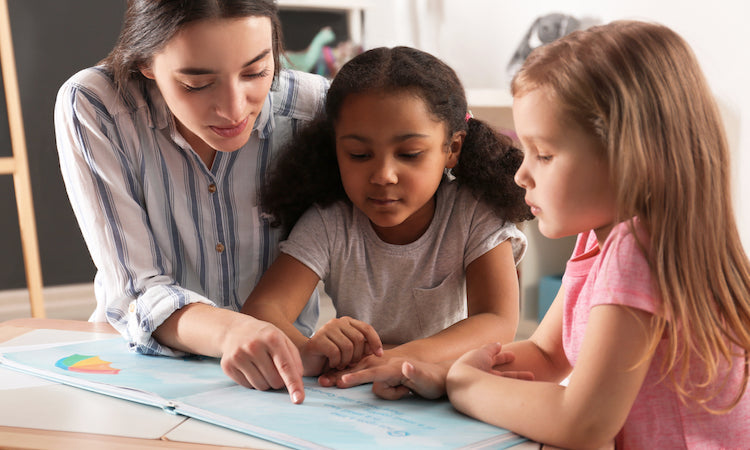By Beth Richards, Literacy Interventionist, Reading Recovery Teacher, Guest Blogger
We often have brief windows of opportunity to capitalize on teachable moments that move our students forward as readers. Today's blog post is part of a series written to help you decide on the most important move you can make in the moment when teaching students who are reading at levels D–F.
Examining the Text Structure in Leveled Books (D–F)
Narrative texts at these levels often have a problem and solution, with characters learning a lesson. Students encounter new conventions in print, including dialogue, spacing between paragraphs, and print on both pages. Students need to expand their bank of known words in order to navigate these levels, as well as visually attending to known parts that can help them solve words. Students will need to read in fluent, meaningful phrases in order to attend to the storyline.
Observation to Guide Teaching Decisions
When you are reading with a student, and they come to something tricky, quickly observe how they are trying to use their problem-solving skills. What sources of information are they using: meaning, structure, or visual? Once you’ve noticed what they are using, you should “prompt the child to use information he is ignoring” (Clay 2005, 39). This is crucial for helping students develop a balanced way to problem solve when reading.
 If at difficulty a child makes a meaningful attempt, but neglects the visual, that’s what you need to prompt in the moment to draw their attention to it. If a visual attempt is made, do not prompt the child to use visual! They are already using that, and your prompt may mislead a child to think that visual is more important than the other cueing systems.
If at difficulty a child makes a meaningful attempt, but neglects the visual, that’s what you need to prompt in the moment to draw their attention to it. If a visual attempt is made, do not prompt the child to use visual! They are already using that, and your prompt may mislead a child to think that visual is more important than the other cueing systems.
Sometimes, prompts are not enough, and the situation may require a demonstration, explicit teaching, or scaffolded practice. Prompting is merely a reminder to do something that you have already taught the child to do. If you haven’t yet taught it, you can’t prompt for it.
Finally, you can always praise something the child did well independently that she has been struggling with. This lets the child know that what she has just done is important and indicative of good reading. When teaching, you should take into consideration your students’ individual needs while directing your teaching point toward one of the following behaviors:
- attending to new conventions of the print
- adding more known words to their repertoire
- trying out new types of language structure
- cross-checking one source of information against another or making integrated attempts
- noticing when something isn’t right
- learning to search unknown words for a part that is already known
Attending to New Conventions of the Print
Students may need guidance in navigating new structures. In the moment, you may realize they are confused by things such as quotation marks, print on both sides, white space between sentences, dialogue tags prior to the sentence instead of after, or sentences that do not end at the end of the line. Look at this example of a student’s troubles with Buddy Boy and His Skateboard .
 Prior to this, the child may have only seen taglines after the sentence, so starting with “Dad said . . .” is unexpected. A quick prompt of
The author is telling us that Dad is talking
helped the child work through this spot. Also, the line ends with the word
come
, but then the sentence continues to the next line. The student had not encountered that often in text, so he read it as if there were a period after
come
.
Prior to this, the child may have only seen taglines after the sentence, so starting with “Dad said . . .” is unexpected. A quick prompt of
The author is telling us that Dad is talking
helped the child work through this spot. Also, the line ends with the word
come
, but then the sentence continues to the next line. The student had not encountered that often in text, so he read it as if there were a period after
come
.
This made the rest of the sentence confusing and unpredictable. Saying the following helps the reader keep going: There’s no period there; Dad’s not done talking. Try that again and don’t stop until you get here . Anything you support during the reading can be revisited after as well.
To read about more details of the behaviors listed above with guidance on what to say when these are not yet controlled or neglected by students, be sure to visit our blog soon for the next part of this series on making thoughtful decisions at specific guided reading levels!
 Beth has been teaching for seventeen years. She has taught kindergarten, third, and fourth grades in Wisconsin. For the last six years, she has been a literacy interventionist and Reading Recovery teacher and loves spending her days helping her students develop and share her love of reading.
Beth has been teaching for seventeen years. She has taught kindergarten, third, and fourth grades in Wisconsin. For the last six years, she has been a literacy interventionist and Reading Recovery teacher and loves spending her days helping her students develop and share her love of reading.




















































